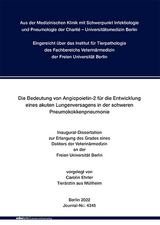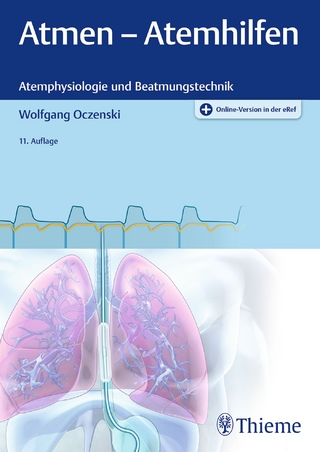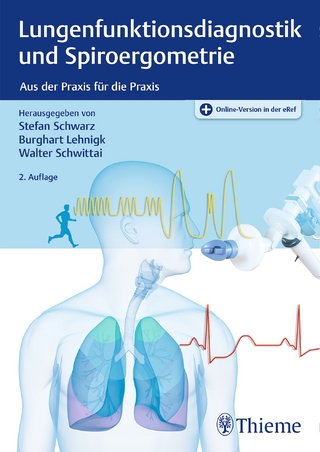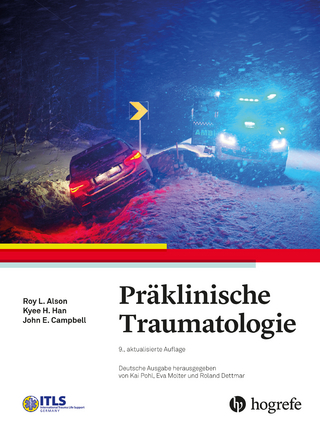Die Bedeutung von Angiopoietin-2 für die Entwicklung eines akuten Lungenversagens in der schweren Pneumokokkenpneumonie
Seiten
2022
|
1. Auflage
Mensch & Buch (Verlag)
978-3-96729-181-0 (ISBN)
Mensch & Buch (Verlag)
978-3-96729-181-0 (ISBN)
Schwere bakterielle Pneumonien führen häufig zu einer Schädigung der Lunge. Ein bedeutender Erreger einer schweren Pneumonie ist das grampositive Bakterium Streptococcus pneumoniae. Im Verlauf einer Pneumokokkenpneumonie kann es durch direkten Einfluss von Pathogenitätsfaktoren sowie der körpereigenen Abwehrreaktion zu einer erhöhten endothelialen Permeabilität und einem pulmonalen Barriereversagen kommen, welches in schweren Fällen in ein akutes Lungenversagen münden kann. Angiopoietin-2 ist ein körpereigener Ligand des endothelial vorkommenden Tyrosinkinase-Rezeptors Tie-2. Das Protein hat einen bekannten proinflammatorischen und destabilisierenden Einfluss auf das Gefäßsystem und wird nach einer Stimulation mit Pneumolysin, einem Virulenzfaktor von Streptococcus pneumoniae, vermehrt vom pulmonalen Endothel ausgeschüttet. Die Bedeutung von Angiopoietin-2 in der schweren Pneumokokkenpneumonie ist noch unbekannt. Ziel der vorliegenden Doktorarbeit war es, den Einfluss von Angiopoietin-2 auf das inflammatorische Geschehen und die pulmonale Barrierestabilität in der schweren Pneumokokkenpneumonie mit einhergehendem akuten Lungenversagen näher zu untersuchen. Hierzu wurde ein konditionelles Angiopoietin-2-Knockout-Mausmodell verwendet. Der Knockout der gezüchteten Angiopoietin-2-loxP/loxP-Cre-ERT2 Mauslinie wurde in vivo mit Tamoxifen und in vitro mit 4 -Hydroxytamoxifen induziert. In anschließenden Versuchen wurde die Effizienz des induzierten Angiopoietin-2-Knockout untersucht. Hierbei zeigten die Angiopoietin-2-Knockout-Mäuse eine lückenhafte Gendeletion. Die induzierten Mäuse wiesen im Vergleich zu ihren nicht induzierbaren Geschwistertieren, welche als Kontrolle dienten, zwar eine deutlich verringerte Expression von Angiopoietin-2 auf, eine vollständige Deletion des Proteins konnte jedoch nicht erzielt werden. In vitro bestätigten die erhobenen Daten die bereits bekannte destabilisierende Wirkung von Angiopoietin-2 auf das pulmonale Endothel. Primäre murine pulmonale Endothelzellen von Angiopoietin-2-Knockout-Mäusen wiesen nach einer Stimulation mit Pneumolysin im Vergleich zu pulmonalen Endothelzellen von Kontrollmäusen einen geringeren Integritätsverlust des Zellmonolayers auf. In ergänzenden in vivo Studien zeigten die mit Streptococcus pneumoniae infizierten Angiopoietin-2-Knockout-Mäuse einen verringerten Angiopoietin-2-Plasmaspiegel als die Kontrollmäuse. Ein Unterschied im inflammatorischen Geschehen sowie der alveolokapillären Barierrefunktion war zwischen den Gruppen jedoch nicht ersichtlich, so dass die protektive Wirkung eines Angiopoietin-2-Knockout in der Pneumokokkenpneumonie in diesem Versuchssetting nicht bestätigt werden konnte. Gründe für die abweichenden Ergebnisse der in vitro und in vivo Studie könnten in der verwendeten Mauslinie, deren unvollständigen Induzierbarkeit, sowie im Versuchsdesign liegen. Die Untersuchung des Proteins auch im Hinblick auf die Notwendigkeit neuer innovativer Therapiestrategien bei einem Pneumonie-induzierten akuten Lungenversagen bleibt eine bedeutende Fragestellung. Neben der Erprobung weiterer Tamoxifen-Induktionsprotokolle zum Erreichen einer effektiveren Ang-2 Deletion, oder der Verwendung eines anderen in vivo Versuchdesigns (früherer Analysezeitpunkt
oder Einsatz einer Antibiotikabehandlung), sollte die Verwendung einer anderen Mauslinie zur Erforschung des Einflusses von Angiopoietin-2 im Verlauf einer Pneumokokkenpneumonie in Betracht gezogen werden. The role of Angiopoietin-2 in the development of acute lung failure in severe pneumococcal pneumonia
Severe bacterial pneumonia frequently leads to permanent lung damage. A significant pathogen of severe pneumonia is the gram-positive bacterium Streptococcus pneumoniae. In the course of pneumococcal pneumonia, both the pathogen itself and the inflammatory response to the pathogen can lead to increased endothelial permeability and pulmonary barrier failure finally leading to life-threatening respiratory failure. Angiopoietin-2 is an endogenous ligand of the tyrosine kinase receptor Tie-2. Angiopoietin-2 has known pro-inflammatory and destabilizing effects on the vascular system and is increasingly released from the pulmonary endothelium following stimulation with pneumolysin, a virulence factor of Streptococcus pneumoniae. However, the precise role of Angiopoietin-2 in severe pneumococcal pneumonia is still unclear. The goal of this study was to elucidate the influence of Angiopoietin-2 on inflammatory processes and alveolar-capillary barrier integrity in severe pneumococcal pneumonia with acute respiratory failure. Therefore, a conditional Angiopoietin-2-knockout mouse model was used. The knockout was induced in vivo in the Angiopoietin-2-loxP/loxP-Cre-ERT2-line of mice using Tamoxifen and in vitro using 4-Hydroxytamoxifen. In subsequent experiments, the efficiency of the Angiopoietin-2-knockout was determined. The Angiopoietin-2-knockout showed an incomplete gene deletion of Angiopoietin-2. Compared with their non-inducible siblings, which served as controls, the induced mice showed a reduced expression of angiopoietin-2, but a complete deletion of the protein could not be achieved. In vivo data confirmed previously established findings that Angiopoietin-2 has a destabilizing effect on the pulmonary endothelium. Pulmonary endothelial cells from Angiopoietin-2-knockout mice showed reduced loss of integrity in their cell monolayers following stimulation with pneumolysin when compared to controls. Further in vivo studies also showed reduced Angiopoietin-2 plasma levels in Streptococcus pneumoniae infected Angiopoietin-2-knockout mice compared to their controls. No differences were observed between the groups in markers of the inflammatory process or in the state of the alveolar-capillary barrier. Therefore, a protective effect of Angiopoietin-2-knockout in pneumococcal pneumonia could not be demonstrated in this experiment with regard to these parameters. The discrepancies in findings between the in vitro and in vivo data could be due to the inherent variability between the mice themselves, its incomplete inducibility but also to the study design. Further studies to investigate the significance of this protein for the establishment of new, innovative therapeutic strategies for pneumonia-associated lung failure should be considered. In addition to investigating additional Tamoxifen induction protocols to achieve more effective Ang-2 deletion, or designing another in vivo study (e.g., regarding earlier analysis or initiation of antibiotic treatment), the use of another mouse line to investigate the role of Antiopoietin-2 in the course of pneumococcal pneumonia should be considered.
oder Einsatz einer Antibiotikabehandlung), sollte die Verwendung einer anderen Mauslinie zur Erforschung des Einflusses von Angiopoietin-2 im Verlauf einer Pneumokokkenpneumonie in Betracht gezogen werden. The role of Angiopoietin-2 in the development of acute lung failure in severe pneumococcal pneumonia
Severe bacterial pneumonia frequently leads to permanent lung damage. A significant pathogen of severe pneumonia is the gram-positive bacterium Streptococcus pneumoniae. In the course of pneumococcal pneumonia, both the pathogen itself and the inflammatory response to the pathogen can lead to increased endothelial permeability and pulmonary barrier failure finally leading to life-threatening respiratory failure. Angiopoietin-2 is an endogenous ligand of the tyrosine kinase receptor Tie-2. Angiopoietin-2 has known pro-inflammatory and destabilizing effects on the vascular system and is increasingly released from the pulmonary endothelium following stimulation with pneumolysin, a virulence factor of Streptococcus pneumoniae. However, the precise role of Angiopoietin-2 in severe pneumococcal pneumonia is still unclear. The goal of this study was to elucidate the influence of Angiopoietin-2 on inflammatory processes and alveolar-capillary barrier integrity in severe pneumococcal pneumonia with acute respiratory failure. Therefore, a conditional Angiopoietin-2-knockout mouse model was used. The knockout was induced in vivo in the Angiopoietin-2-loxP/loxP-Cre-ERT2-line of mice using Tamoxifen and in vitro using 4-Hydroxytamoxifen. In subsequent experiments, the efficiency of the Angiopoietin-2-knockout was determined. The Angiopoietin-2-knockout showed an incomplete gene deletion of Angiopoietin-2. Compared with their non-inducible siblings, which served as controls, the induced mice showed a reduced expression of angiopoietin-2, but a complete deletion of the protein could not be achieved. In vivo data confirmed previously established findings that Angiopoietin-2 has a destabilizing effect on the pulmonary endothelium. Pulmonary endothelial cells from Angiopoietin-2-knockout mice showed reduced loss of integrity in their cell monolayers following stimulation with pneumolysin when compared to controls. Further in vivo studies also showed reduced Angiopoietin-2 plasma levels in Streptococcus pneumoniae infected Angiopoietin-2-knockout mice compared to their controls. No differences were observed between the groups in markers of the inflammatory process or in the state of the alveolar-capillary barrier. Therefore, a protective effect of Angiopoietin-2-knockout in pneumococcal pneumonia could not be demonstrated in this experiment with regard to these parameters. The discrepancies in findings between the in vitro and in vivo data could be due to the inherent variability between the mice themselves, its incomplete inducibility but also to the study design. Further studies to investigate the significance of this protein for the establishment of new, innovative therapeutic strategies for pneumonia-associated lung failure should be considered. In addition to investigating additional Tamoxifen induction protocols to achieve more effective Ang-2 deletion, or designing another in vivo study (e.g., regarding earlier analysis or initiation of antibiotic treatment), the use of another mouse line to investigate the role of Antiopoietin-2 in the course of pneumococcal pneumonia should be considered.
| Erscheinungsdatum | 10.04.2024 |
|---|---|
| Verlagsort | Berlin |
| Sprache | deutsch |
| Maße | 148 x 210 mm |
| Gewicht | 350 g |
| Themenwelt | Medizinische Fachgebiete ► Innere Medizin ► Pneumologie |
| Veterinärmedizin ► Vorklinik | |
| Schlagworte | acute respiratory distress syndrome • Akutes Atemnotsyndrom • Animal Models • Endothel • Endothelium • Entzündung • inflammation • Liganden • Ligands • Lungenentzündung • Mäuse • mice • Pneumologie • Pneumonia • Streptococcus pneumoniae • Tiermodelle |
| ISBN-10 | 3-96729-181-2 / 3967291812 |
| ISBN-13 | 978-3-96729-181-0 / 9783967291810 |
| Zustand | Neuware |
| Haben Sie eine Frage zum Produkt? |
Mehr entdecken
aus dem Bereich
aus dem Bereich
Aus der Praxis für die Praxis
Buch (2022)
Thieme (Verlag)
71,00 €
International Trauma Life Support (ITLS)
Buch | Softcover (2024)
Hogrefe AG (Verlag)
70,00 €




